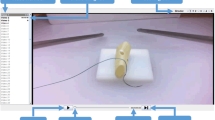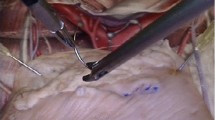Abstract
Background
The assessment of technical skills should provide objective feedback and judge suitability of progress during training. The aim of this study was to validate two objective assessment techniques for laparoscopic suturing and demonstrate a correlation between them.
Methods
Six experts, seven surgeons skilled in laparoscopic suturing, and 13 with no laparoscopic suturing skills were asked to place two or three intracorporeal sutures on a synthetic suture pad. The latter group was given video-based instructions prior to the execution of the sutures. Ergonomic conditions were standardized for all subjects. The procedures were recorded on videotape and two blinded observers rated the first suture of each subject on a 29-point checklist. A motion analysis system, Imperial College Surgical Assessment Device, was used to assess psychomotor skills.
Results
There was a significant difference in the time taken (p=0.000) and total path length (p=0.000) per suture across the groups. There were also a significant difference in the total checklist score (p=0.000) and its individual categories. The was a strong correlation between the total path length and the total checklist score (coefficient, 0.78;p<0.001).
Conclusions
A combination of the motion analysis system and the checklist would make the process of formative feedback during the learning of intracorporeal suturing objective and comprehensive.
Similar content being viewed by others
References
Cagir B, Rangraj M, Maffuci L, Herz BL (1994) The learning curve for laparoscopic cholecystectomy. J Laparoendose Surg 4: 419–427
Chung JY, Sackier JM (1998) A method of objectively evaluating improvements in laparoscopic skills. Surg Endosc 12: 1111–1116
Cuschieri A, Francis N, Crosby J, Hanna GB (2001) What do master surgeons think of surgical competence and revalidation? Am J Surg 182:110–116
Deziel DJ, Millikan KW, Economou SG, Doolas A, Ko ST, Airan MC (1993) Complications of laparoscopic cholecystectomy: a national survey of 4,292 hospitals and an analysis of 77,604 cases. Am J Surg 165: 9–14
Eubanks TR, Clements RH, Pohl D, Williams N, Schaad DC, Horgan S, et al. (1999) An objective scoring system for laparoscopic cholecystectomy. J Am Coll Surg 189: 566–574
Fleshman JW, Fry RD, Birnbaum EH, Kodner IJ (1996) Laparoscopic-assisted and minilaparotomy approaches to colorectal diseases are similar in early outcome. Dis Colon Rectum 39: 15–22
Gallagher AG, Satava RM (2002) Virtual reality as a metric for the assessment of laparoscopic psychomotor skills. Learning curves and reliability measures. Surg Endosc 16: 1746–1752
Kopta JA (1971) An approach to the evaluation of operative skills. Surgery 70: 297–303
Lekawa M, Shapiro SJ, Gordon LA, Rothbart J, Hiatt JR (1995) The laparoscopic learning curve. Surg Laparosc Endosc 5: 455–458
Mori T, Hatano N, Maruyama S, Atomi Y (1998) Significance of “hands-on training” in laparoscopic surgery. Surg Endosc 12: 256–260
Peters JH, Ellison EC, Innes JT, Liss JL, Nichols KE, Lomano JM, et al. (1991) Safety and efficacy of laparoscopic cholecystectomy. A prospective analysis of 100 initial patients. Ann Surg 213: 3–12
Regehr G, MacRae H, Reznick RK, Szalay D (1998) Comparing the psychometric properties of checklists and global rating scales for assessing performance on an OSCE-format examination. Acad Med 73: 993–997
Reznick RK (1993) Teaching and testing technical skills. Am J Surg 165: 358–361
Rosser JC, Rosser LE, Savalgi RS (1997) Skill acquisition and assessment for laparoscopic surgery. Arch Surg 132: 200–204
Rosser JC Jr, Rosser LE, Savalgi RS (1998) Objective evaluation of a laparoscopic surgical skill program for residents and senior surgeons. Arch Surg 133: 657–661
Royston CM, Lansdown MR, Brough WA (1994) Teaching laparoscopic surgery: the need for guidelines. Br Med J 308: 1023–1025
Simons AJ, Anthone GJ, Ortega AE, Franklin M, Fleshman J, Geis WP, et al. (1995) Laparoscopic-assisted colectomy learning curve. Dis Colon Rectum 38: 600–603
Smith CD, Farrell TM, McNatt SS, Metreveli RE (2001) Assessing laparoscopic manipulative skills. Am J Surg 181: 547–550
Smith SG, Torkington J, Brown TJ, Taffinder NJ, Darzi A (2002) Motion analysis. Surg Endosc 16: 640–645
Spencer FC, Spencer FC (1978) Teaching and measuring surgical techniques the technical evaluation of competence. Bull Am Coll Surgeons 63: 9–12
Taffinder N, Smith S, Mair J, Russell R, Darzi A (1999) Can a computer measure surgical precision? Reliability, validity and feasibility of the ICSAD. Surg Endose 13(suppl 1): 81
Watts J, Feldman WB (1985) Assessment of technical skills. In: Neufeld VR, Norman GR (eds). Assessing clinical competence. Springer: New York, pp 259–274
Author information
Authors and Affiliations
Additional information
Online publication: 13 October 2004
Rights and permissions
About this article
Cite this article
Moorthy, K., Munz, Y., Dosis, A. et al. Bimodal assessment of laparoscopic suturing skills. Surg Endosc 18, 1608–1612 (2004). https://doi.org/10.1007/BF02637130
Received:
Accepted:
Issue Date:
DOI: https://doi.org/10.1007/BF02637130




